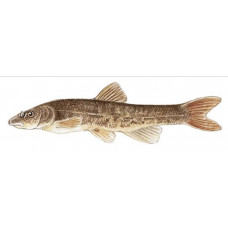Latin name
Rhinichthys cataractae
Other names
No information
Identification
Dace have a slender body. Most species have terminal antennae. The pearl dace (Semotilus margarita margarita) has a whisker that is sometimes hidden or even absent. Clinostomus species do not have whiskers. Identifying and distinguishing between the different species of dace is difficult. Although they are not all the same, the differences are minor, e.g. the snout is slightly longer. The colouring is olive green, tending to white on the belly, with silvery touches. The fine scales are pronounced and have dark patterns that can vary not only between species but also between individuals.
Distribution
In North America, dace are widely distributed in small streams, lakes and ponds and are an important food source for many species. They live in cooler, more mobile, clear water that flows over gravel or pebbles. Adults usually live in deep water, while juveniles live in shallow water near the shore.
Habitat
Dace are highly prized as bait for big game. They can survive in very crowded or stagnant waters because of their low oxygen demand, so anglers who need a lively and durable bait will appreciate this resistance.
Size
Commonly referred to in North America under the all-encompassing generic term 'minnows', the dace is small, 2 to 3 inches long.
Life history and Behavior
All dace, especially males, have well-developed tubercles on their bodies, especially around the head and snout. These tubercles, also known as bead organs, are used for nest building, fighting and courtship rituals, and for maintaining contact with the opposite sex during spawning.
Food and feeding habits
After spawning, the eggs receive little parental care and the young feed on zooplankton and phytoplankton for the first few months of life. Adults feed on insect larvae, worms and algae.
Reproduction
No information
| Classification | |
| Phylum | Chordata |
| Class | Actinopterygii |
| Squad | Cypriniformes |
| Family | Cyprinidae |
| Genus | Rhinichthys |
| Species | R. cataractae |
| Features | |
| Conservation status | Least Concern |
| Habitat | Bottom |
| Life span, years | 5 |
| Maximum body weight, kg | No information |
| Maximum length, cm | 17 |
| Sailing speed, m/s | No information |
| Threat to people | Edible |
| Way of eating | Bentophage |
Dace
Tags: Dace

